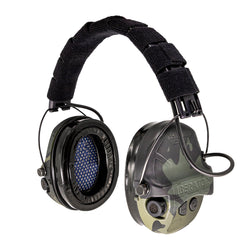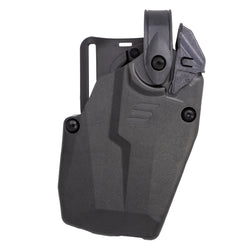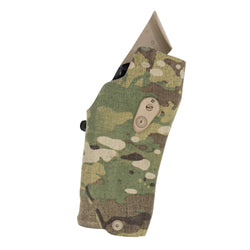The armed citizen often takes their cues from the latest firearm trends in law enforcement. The endorsement and issuance of any small arms by major departments is perhaps the greatest form of marketing to get public interest. But in the early days of American law enforcement, it was the police who played catch-up.
Police departments in the 19th century were a new and suspicious concept of law enforcement. Initially, police went unarmed, but once the need for firepower arose, a litany of military and commercial handguns filled the gap. Here is a look at some of the most popular American police handguns of the 19th century.
America’s first policemen
Early Americans distrusted large armed bodies that might impose their will on the people. To address these fears, the Bill of Rights was added to the Constitution in 1791, ensuring clear limits on federal power. American colonists had dealt with legalized kidnapping and tyranny predicated on law enforcement metered out by the British Army. Unfortunately, military enforcement of civilian law was a fact of life in Europe that had to be negated in the New World.
In early America, law enforcement fell to the office of the sheriff. The sheriff is a facet of English law, a civilian who administered civil and criminal law. He was elected to office and, in theory, accountable to the people of his county. But as the country grew, so did America’s cities.
With more people, there was more crime to investigate and deter, and more laws and contracts to be enforced. To do that, cities needed more police and ways of collecting institutional knowledge to make law enforcement more efficient, effective, and equitable.

The first police department, as we know it, came about in 1845 with the founding of the NYPD. The department was tasked with policing a city of nearly 400,000 people, including keeping the peace between nativist Know Nothing gangs and Irish immigrants. For organizational inspiration, the NYPD drew inspiration from the London Metropolitan Police Department, which dated back to 1829.
The London Metropolitan Police was the first professional police department and fielded departments of beat cops, investigators, medical, and evidence specialists to enforce the law in the world’s largest city. The NYPD was founded on the same lines and even went so far as to adopt similar uniforms, similar copper badges, and a no-firearms policy.
In short order, other Eastern cities developed their own municipal departments patterned after London. In terms of weaponry, early coppers could rely on the truncheon or Billy club to force compliance. Officially, firearms could be carried, but none were issued. As a rule, officers went about their day unarmed.
After the shooting of Sergeant William Jourdan during Baltimore’s first city council election, the recently established Baltimore Police Department purchased 200 Colt 1849 Pocket revolvers for issue to its officers. The armed policeman was now a reality.
Most Popular Police Pistols of the 19th Century
The Colt 1849 Pocket Revolver
The Colt Pocket Model was already a commercial success when the Baltimore PD purchased its first batch. Samuel Colt had emerged from bankruptcy to find success in the military market with the Walker revolver. But to stay afloat in a time of peace, he developed a smaller and lighter handgun that could be offered to the civilian market.
His instincts were right on. In fact, the Colt Pocket model was Colt’s most popular handgun of that century. Between 1850 and 1873, nearly 350,000 were made.

The Colt Pocket Model is a five-shot .31 caliber revolver. It is a muzzle-loading handgun that requires loading of powder and ball from the front of the cylinder. Percussion caps were added to the cones at the rear of the cylinder in order to fire.
Although underpowered by today’s standards, the Colt Pocket .31 was better than existing single-shot pistols, as the officer had five rounds on tap. It was also light enough to slip into an officer’s coat or pants pocket, allowing the public to be more at ease while being effectively armed. The Colt Pocket was popular among all groups, ranging from gamblers to politicians, and the adoption by multiple departments was icing on the cake.
In 1861, Colt reworked the Pocket .31 to take a more powerful .36 caliber bullet in the same small package. Colt aimed it directly at law enforcement by billing it as the Colt New Police, a moniker that would be used again and again as the years went on for new and completely different revolvers. Sometimes called the 1862 Pocket Police, this model was not as successful, but together the Colt Pocket line dominated law enforcement sales into the years following the Civil War.
The Colt 1851 and 1860 Revolvers
Back East, police departments would stick with small pocket-sized handguns to discreetly outfit their officers. But in the years after the Civil War, Western lawmen most often opted for big iron.

In the West, the Sheriff and his deputies reigned, along with the US Marshals who sought to enforce federal law. Professional departments in these sparse parts were in their infancy, and attitudes towards firearms were far different in the 1860s and 1870s than only a few decades before.
West of the Mississippi, preferred handguns tended to be bigger. There were bigger four-legged threats, more two-legged threats, and a general understanding that a handgun in the open was perfectly in place, rather than out of place as in Eastern cities. After the war, many a young man who had been shown the cheapness of life also carried around a pistol. Surplus Remington and Colt revolvers were so common, it was hard for the manufacturers to make new ones.
The Colt 1851 Navy and Colt 1860 Army revolvers were popular Civil War sidearms that found favor with lawmen in the West. Well-balanced and adequately powered, these six shooters were preferred by the likes of Wild Bill Hickok and Buffalo Bill Cody, to name a few. Once cartridge handguns became readily available, handguns like the Smith & Wesson American proved immediately popular. But the Colt Single Action Army would prove an enduring favorite for decades.

The Colt Single Action Army Revolver
The Single Action Army was adopted by the US Cavalry in 1873 and was made available for commercial sales late in that year. As the pistol made its way into service, the logistics of providing spare parts and ammunition across a vast network of posts made it an easy win for lawmen looking to be armed.

Like other handguns seen here, the SAA is a single action handgun that requires the hammer to be cocked for every shot. It also loaded and unloaded through a gate, one round at a time, until the cylinder was either full or empty.
But what put the SAA ahead of other handguns like the break-top Smith & Wesson revolvers available is in ergonomics. The SAA’s plow handle grip made the revolver a natural pointer, and the hammer was perfectly positioned for rapid cocking and firing without breaking the grip on the handgun. Although the Smith & Wesson could be reloaded quickly, it was also easier to lose rounds in a dynamic environment, whereas the Colt always had rounds on board.
The Colt Single Action Army debuted in .45 Colt, but it was available in calibers ranging from .32-20 to .44-40—all of which blew away most handgun cartridges used back East. The Single Action Army would go on to become an icon of Western cinema, partly because so many of them were still in use in Western districts well into the 20th century.
The Smith & Wesson Lemon Squeezer
Smith & Wesson’s big .44 caliber single-actions like the American and the No. 3 were surprisingly common on the Western frontier, despite what the movies depict. In 1877, Smith & Wesson created a double-action version with their No. 3 Frontier model in .44-40. Instead of having to cock the hammer with every shot, the revolver could be fired by simply pressing the trigger. This allowed for rapid follow-up shots if need be.
Although the Frontier was not the first double-action revolver out there, it was the first in a line of popular handguns, the most popular of which is the little Smith & Wesson New Departure. Originally designed for civilian concealed carry, the New Departure debuted in 1887 and ran until 1940.
It featured a hammerless design that prevents snagging on the draw and a grip safety that prevents accidental discharge. Like its bigger brothers, it is a break-top design that features simultaneous ejection for rapid and convenient reloading over gate-loaded pistols.

The New Departure quickly became known as the Lemon Squeezer, thanks to its grip safety. It was available in either .32 S&W or .38 S&W. The caliber and small size made it a boon for Eastern cops looking to replace their aging single-action pocket pistols.
The New Departure’s popularity inspired Iver Johnson, Hopkins & Allen, and H&R to produce their own versions. Hopkins & Allen’s Safety Police model was clearly intended for law enforcement sales. Pistols like these remained popular well after the next innovation swept it aside—the hand ejector revolver.
The Colt New Police
Modern double-action revolvers usually feature a cylinder that swings out to the side for loading, as well as an ejector rod worked by hand to dump the empty cases. Hand ejector revolvers could be loaded quickly like the earlier top-break revolvers, but had the advantage of a solid frame that could handle more powerful ammunition.
Colt debuted the first hand ejector revolver in 1889, which was adopted by the US Army in 1892. This model had some commercial success, but the Colt New Police that followed it achieved widespread adoption.

The Colt New Police is a six-shot hand ejector revolver and a direct response to the Smith & Wesson Hand Ejector, which came out in 1896. Colt went as far as to copy the new .32 S&W Long cartridge the Smith & Wesson revolver used. This cartridge had a flat-nosed instead of a round-nosed 98 grain bullet and was dubbed the .32 Colt New Police.
No matter what name you call it, the .32 Long had more power than the old .32 S&W cartridge and is readily chambered in relatively compact handguns. It is also an unusually accurate cartridge. These attributes spelled popularity with beat cops who did their patrolling on foot and seldom had marksmanship practice.
But attitudes towards training were shifting. Dissatisfied with the shooting of NYPD officers, the great sportsman and then-NYPD Police Commissioner Theodore Roosevelt made the Colt New Police standard issue, the first in the department’s history. He also mandated basic marksmanship standards that had to be met on a yearly basis.
The Colt New Police was produced from 1896 until 1907, when it was succeeded by a more drop-safe option, the Colt Police Positive. But together with the S&W Hand Ejector, urban departments standardized on this pair of revolvers, and the .32 S&W Long became the universal police cartridge of its day.
The .32 remained favored through the 1920s until the rise of the motor bandit during the Depression caused police officers to finally dispense with their penchant for small handguns in favor of medium-sized service revolvers in .38 Special and .357 Magnum.
19th Century Police Guns: A Pound of Optimism or Caution?
The 21st-century policeman has a pick of protective gear and as much firepower as one person can tote around. Guns, ammo, sprays, cuffs, batons, lights, and body armor are standard issue, and there are countless trainings out there to use them effectively. So, too is the amount of training to de-escalate altercations, prevent crime, and apprehend the criminal element.

The equipment and training of the 19th-century copper pales in comparison, as did the attitudes toward it. Ever mindful of armed tyranny at the start of the century, early policemen were distinguished by the badge and uniform, but no gun. But as cities grew, so did the organizations needed to support them.
Gradually, the need for sidearms took precedence over ideals. Even so, the ideal held on in the form of small pocket pistols ideal for carry prevailed so that the illusion of an unarmed force could be maintained. Training was learning by doing in real gun fights and dedicated practice off duty.
The first gunfighters on both sides of the law prevailed after the Civil War. By the end of the century, forensic science and police procedures were primitive but increasingly standardized, as was the need for marksmanship training. The policeman and the police department, as they developed in that century, are representative of a nation clawing away from naive notions into maturity.









